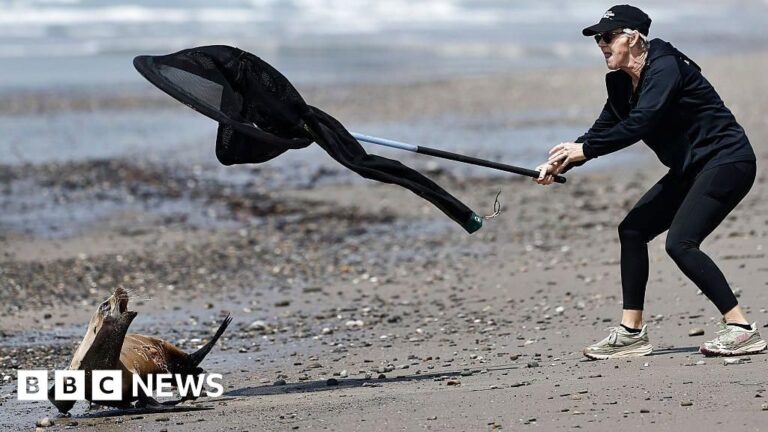In the aftermath of the fatal Texas floods, some Democrats have warned about the “consequences” of the Trump administration’s cuts to the federal government workforce, including meteorologists. The suggestion is that the cuts may have impeded the ability of the National Weather Service (NWS) to adequately predict the floods and raise the alarm.
The Trump administration has proposed a 25% cut to the National Oceanic and Atmospheric Administration’s (NOAA) current annual budget of $6.1bn. NOAA is the agency which oversees the NWS. This would take effect in the 2026 financial year, which begins in October this year, so these particular cuts would not have contributed to the Texas tragedy.
However, the staffing levels of the NWS have already been separately reduced by the Trump administration’s efficiency drive since January. The Department of Government Efficiency offered voluntary redundancies, known as buyouts, as well as early retirements to federal government workers. It also ended the contracts of most of those who were on probation.
As a result, about 200 people at the NWS took voluntary redundancy and 300 opted for early retirement, according to Tom Fahy, the director of the NWS union. A further 100 people were ultimately fired from the service, he said. In total, the NWS lost 600 of its 4,200 staff, says Mr Fahy, causing several offices across the country to operate without the necessary staffing.
In April, the Associated Press news agency said it had seen data compiled by NWS employees showing half of its offices had a vacancy rate of 20% – double the rate a decade earlier. Despite this, climate experts told BBC Verify that the NWS forecasts and flood warnings last week in Texas were as adequate as could be expected.
The forecasts and warnings all played out in a normal manner, according to Avantika Gori, an assistant professor of civil and environmental engineering at Rice University in Texas. Andy Hazelton, a climate scientist who modelled hurricane paths for the NOAA until he was fired during the layoffs in February, also said, “I don’t think the staffing issues contributed directly to this event. They got the watches and the warnings out.”
However, some experts have suggested that staffing cuts may have impeded the ability of local NWS offices in Texas to effectively co-ordinate with local emergency services. Daniel Swain, a climate scientist at University of California Los Angeles, said, “There is a real question as to whether the communication of weather information occurred in a way that was sub-optimal.”
The San Angelo and San Antonio offices, which cover the areas affected by the flooding, reportedly had some existing vacancies. The San Antonio office’s website lists several positions as being vacant, including two meteorologists. The NWS union director told BBC Verify that the San Angelo office was missing a senior hydrologist, a scientist who specialises in flooding events.
The San Antonio office also lacked a “warning coordinating meteorologist”, who coordinates communications between local forecasting offices and emergency management services in communities, Mr Fahy said. However, he noted that both offices had temporarily upped their staffing in anticipation of a dangerous weather event, which is typical in these circumstances.
The NWS weather forecast offices in Austin/San Antonio and San Angelo, Texas had additional forecasters on duty during the catastrophic flooding event, according to NWS spokeswoman Erica Grow Cei. All forecasts and warnings were issued in a timely manner, she added. NWS meteorologist Jason Runyen, who covers the San Antonio area, also said that where the office would typically have two forecasters on duty during clear weather, they had “up to five on staff”.
When asked on Sunday if government cuts had left key vacancies unfilled at the NWS, President Trump told reporters, “No, they didn’t.” In a video shared thousands of times on social media, US meteorologist John Morales said, “There has been a 20% reduction in weather balloon releases, launches… What we’re starting to see is that the quality of the forecasts is becoming degraded.”
Weather balloons are an important tool used by meteorologists to collect weather data – from temperatures, to humidity, pressure, or wind speed – from the upper atmosphere. In the US, NWS stations would typically launch them twice a day. In a series of public statements released since February, the NWS confirmed that it either suspended or reduced weather balloon launches in at least 11 locations across the country, which it attributed to a lack of staffing at the local weather forecast offices.
However, there is no evidence to suggest that any of those changes directly affected weather balloon launches in the areas impacted by the floods in Texas. Publicly available data shows that, in the lead-up to the floods, weather balloon launches were carried out as planned at Del Rio, the launch station nearest to the flood epicentre, collecting data that informed weather forecasts which experts say were as adequate as they could be.
Source link




